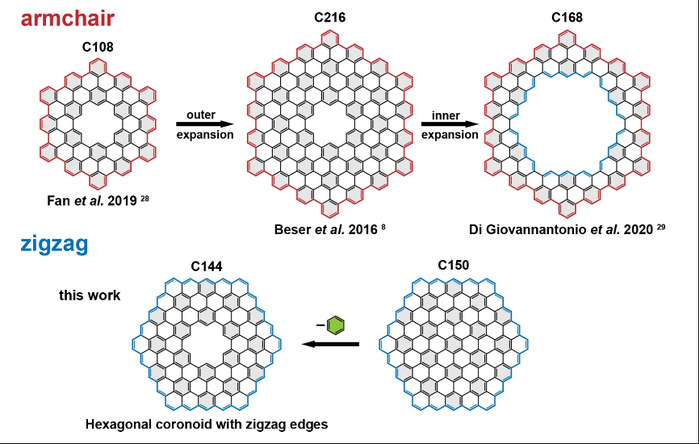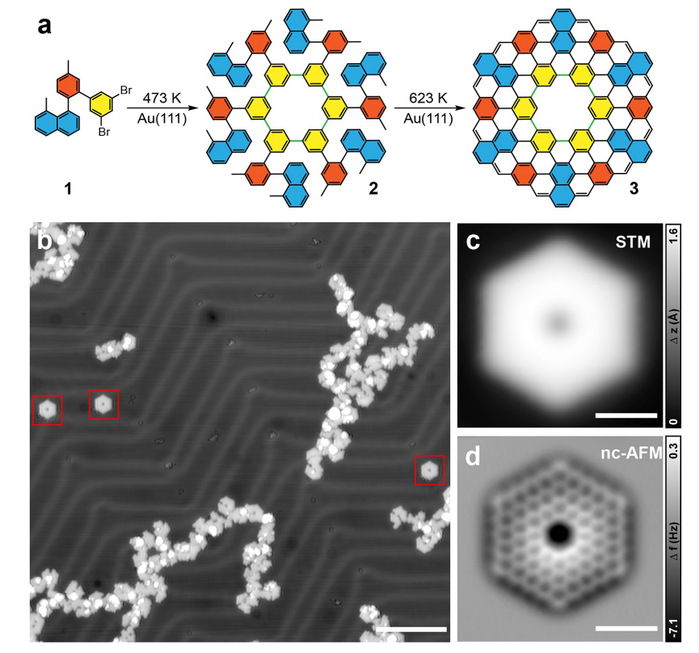Coronoids are polycyclic aromatic compounds formed by annulated benzene rings that enclose a cavity in the center. They can be regarded as nanoporous graphene molecules whose electronic properties are critically dependent on the size and topology of their outer and inner peripheries. They are also ideal models to study the fundamental problem of π-electron delocalization in aromatic systems. In particular, coronoids with zigzag edges along the periphery may have an open-shell multiradical ground state whose intriguing magnetic properties can be precisely tuned by the size and topology of both central hole and external periphery. Because of the tunable magnetic properties, coronoids have potential applications in the field of carbon-based spintronic devices.
To overcome the challenge of synthesizing coronoid in solution as well as the characterization difficulty due to its low solubility, scientists have obtained hexagonal coronoids with specifically designed precursors, which can undergo hierarchical Ullmann coupling and cyclodehydrogenation through on-surface synthesis. However, all the reported coronoids host armchair outer edges rather than zigzag edges, due to the aryl−aryl coupling dominantly occurring along the armchair direction. So far, the hexagonal coronoids with zigzag edges along the external periphery have not been reported, either in solution or on the surface.
Recently, an SPST joint research team composed of Yu Ping's group, Yan Kaking's group and Sun Zhaoru's group has successfully synthesized C144 hexagonal coronoids with zigzag edges on the Au(111) surface for the first time. The result was published in the journal ACS Nano.

In the research, the team designed a precursor 1, consisting of three chemical components (methylnaphthalene, methylbenzene, and 3,5-dibromobenzene), in which the two bromo groups are designed for the macrocylization on surface and the two methyl substituents are expected to undergo cyclodehydrogenation and ring closure reactions to form the zigzag outer edges. The molecular structure of zigzag C144 coronoid is unambiguously evidenced by non-contact atomic force microscopy (nc-AFM) measurements. Its corresponding electronic structures have been further investigated with scanning tunneling microscopy/spectroscopy (STM/STS) measurements, supported by density functional theory (DFT) calculations.

Synthesis and chemical structure characterization of C144 hexagonal coronoid with zigzag edges. (a) On-surface synthetic scheme of coronoid C144. (b) STM overview image on Au(111) after annealing at 623 K. (c,d) Magnified STM and nc-AFM images of 3 after annealing precursor 1 on Au(111) at 473 and 623 K sequentially. Set point: V = 300 mV, I = 50 pA; Δz = 0.03 nm. Scale bars: (b) 10 nm, (c,d) 1 nm
The successful fabrication of C144 hexagonal coronoid with zigzag edge reveals its electronic properties and aromaticity, which provides a new idea for the further synthesis and research of zigzag-edged hexagonal coronoids with multiradical properties.
Third year master students Zhu Xujie, Liu Yanan, and Pu Weiwen are the co-first authors of the article, and Prof. Yu Ping, Prof. Yan Kaking and Prof. Sun Zhaoru are the co-corresponding authors.

